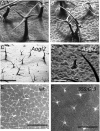Genetic and molecular analysis of trichome development in Arabis alpina
- PMID: 31123146
- PMCID: PMC6575564
- DOI: 10.1073/pnas.1819440116
Genetic and molecular analysis of trichome development in Arabis alpina
Abstract
The genetic and molecular analysis of trichome development in Arabidopsis thaliana has generated a detailed knowledge about the underlying regulatory genes and networks. However, how rapidly these mechanisms diverge during evolution is unknown. To address this problem, we used an unbiased forward genetic approach to identify most genes involved in trichome development in the related crucifer species Arabisalpina In general, we found most trichome mutant classes known in A. thaliana We identified orthologous genes of the relevant A. thaliana genes by sequence similarity and synteny and sequenced candidate genes in the A. alpina mutants. While in most cases we found a highly similar gene-phenotype relationship as known from Arabidopsis, there were also striking differences in the regulation of trichome patterning, differentiation, and morphogenesis. Our analysis of trichome patterning suggests that the formation of two classes of trichomes is regulated differentially by the homeodomain transcription factor AaGL2 Moreover, we show that overexpression of the GL3 basic helix-loop-helix transcription factor in A. alpina leads to the opposite phenotype as described in A. thaliana Mathematical modeling helps to explain how this nonintuitive behavior can be explained by different ratios of GL3 and GL1 in the two species.
Keywords: Arabis alpina; genetic analysis; trichomes.
Conflict of interest statement
The authors declare no conflict of interest.
Figures



Similar articles
-
Arabis alpina: A perennial model plant for ecological genomics and life-history evolution.Mol Ecol Resour. 2022 Feb;22(2):468-486. doi: 10.1111/1755-0998.13490. Epub 2021 Sep 7. Mol Ecol Resour. 2022. PMID: 34415668 Free PMC article. Review.
-
A systems approach reveals regulatory circuitry for Arabidopsis trichome initiation by the GL3 and GL1 selectors.PLoS Genet. 2009 Feb;5(2):e1000396. doi: 10.1371/journal.pgen.1000396. Epub 2009 Feb 27. PLoS Genet. 2009. PMID: 19247443 Free PMC article.
-
Analysis of purified glabra3-shapeshifter trichomes reveals a role for NOECK in regulating early trichome morphogenic events.Plant J. 2010 Oct;64(2):304-17. doi: 10.1111/j.1365-313X.2010.04329.x. Epub 2010 Sep 1. Plant J. 2010. PMID: 21070410
-
SAD2 in Arabidopsis functions in trichome initiation through mediating GL3 function and regulating GL1, TTG1 and GL2 expression.J Integr Plant Biol. 2008 Jul;50(7):906-17. doi: 10.1111/j.1744-7909.2008.00695.x. J Integr Plant Biol. 2008. PMID: 18713401
-
Trichome-Related Mutants Provide a New Perspective on Multicellular Trichome Initiation and Development in Cucumber (Cucumis sativus L).Front Plant Sci. 2016 Aug 10;7:1187. doi: 10.3389/fpls.2016.01187. eCollection 2016. Front Plant Sci. 2016. PMID: 27559338 Free PMC article. Review.
Cited by
-
Genetic and Molecular Analysis of Root Hair Development in Arabis alpina.Front Plant Sci. 2021 Oct 15;12:767772. doi: 10.3389/fpls.2021.767772. eCollection 2021. Front Plant Sci. 2021. PMID: 34721494 Free PMC article.
-
Arabis alpina: A perennial model plant for ecological genomics and life-history evolution.Mol Ecol Resour. 2022 Feb;22(2):468-486. doi: 10.1111/1755-0998.13490. Epub 2021 Sep 7. Mol Ecol Resour. 2022. PMID: 34415668 Free PMC article. Review.
-
Rose without prickle: genomic insights linked to moisture adaptation.Natl Sci Rev. 2021 May 22;8(12):nwab092. doi: 10.1093/nsr/nwab092. eCollection 2021 Dec. Natl Sci Rev. 2021. PMID: 34987840 Free PMC article.
-
Genetic dissection of stem and leaf rachis prickles in diploid rose using a pedigree-based QTL analysis.Front Plant Sci. 2024 Sep 18;15:1356750. doi: 10.3389/fpls.2024.1356750. eCollection 2024. Front Plant Sci. 2024. PMID: 39359628 Free PMC article.
-
CsMYB1 integrates the regulation of trichome development and catechins biosynthesis in tea plant domestication.New Phytol. 2022 May;234(3):902-917. doi: 10.1111/nph.18026. Epub 2022 Mar 12. New Phytol. 2022. PMID: 35167117 Free PMC article.
References
-
- Simpson P., Evolution of development in closely related species of flies and worms. Nat. Rev. Genet. 3, 907–917 (2002). - PubMed
-
- Purugganan M. D., The molecular evolution of development. Bioessays 20, 700–711 (1998). - PubMed
-
- Fernández-Mazuecos M., Glover B. J., The evo-devo of plant speciation. Nat. Ecol. Evol. 1, 110 (2017). - PubMed
Publication types
MeSH terms
Substances
LinkOut - more resources
Full Text Sources

